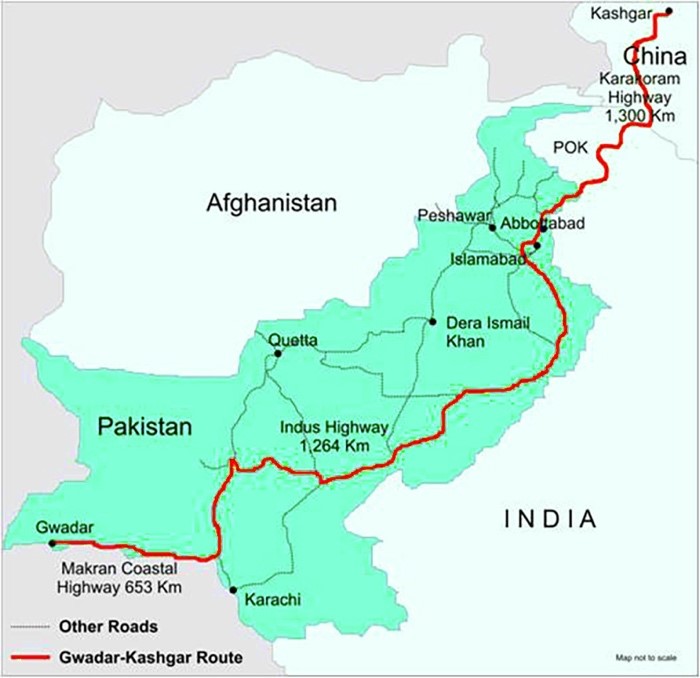Description

Disclaimer: Copyright infringement not intended.
Context
- Pakistan, China and Afghanistan have agreed to forge closer economic ties by extending the Beijing-backed China-Pakistan Economic Corridor (CPEC) to Afghanistan to fully harness the country’s potential as a hub for regional connectivity.
About China–Pakistan Economic Corridor
- It is a 3000 km Chinese infrastructure network project undertaken in Pakistan.
Features
- After the proposal from Chinese President Li Keqiang in 2013, the preliminary study on this project was done in 2014 which acknowledged the hostile environment and complicated geographic conditions but prioritized the importance of having a China-run port near the Gulf of Oman.
- Post this corridor is functional, existing 12,000 km journey of oil transportation to China will be reduced to just 2,395 km.
- This is estimated to save China $2 billion per year.
- China had already acquired control of Gwadar Port in 2013.
- Originally valued at $46 billion, the value of CPEC projects was worth $62 billion as of 2020.
- China refers to this project as revival of the Silk Road.
Aim for China
- This sea-and-land based corridor is aimed to secure and reduce the passage for China's energy imports from the Middle Eastern countries by avoiding existing route from the Straits of Malacca between Malaysia and Indonesia, which in case of a war could be blocked and thus hampering the Chinese energy dependent economic avenues.
- Developing a deep water port at Gwadar in Arabian Sea and a well built road and rail line from this port to Xinjiang Province in western China would be a shortcut for boosting the trade between Europe and China.
- It is also seen as addressing a national security issue for China by economic development of the Xinjiang region thus reducing militant influence on Muslim separatists of native Uyghurs.
.jpeg)
Aim for Pakistan
- In Pakistan, its aim is to overcome an electricity shortfall, infrastructural development and modernize transportation networks.
- Along with shifting it from an agricultural based economic structure to industrial based.
- Pakistani officials predict that CPEC will result in the creation of upwards of 2.3 million jobs between 2015 and 2030, and add 2 to 2.5 percentage points to the country's annual economic growth.
- CPEC envisages to rapidly upgrade Pakistan's required infrastructure and thereby strengthening its economy to an extent by constructing modern transportation networks, numerous energy projects, and special economic zones.
Challenges
- Political regimes in Pakistan are not stable and the civil government establishments have often seen military interference.
- This increases the uncertainty in the commercial environment, unreliable outcomes of investments and endangers the ease of doing business.
- In 2021, local residents of Gwadar protested against the perceived threat to their livelihoods due to illegal fishing in local waters allegedly by Chinese trawlers.
- Sceptics also question on the efficient usage of foreign money to develop the infrastructure given the level of corruption.
- In 2023, the Gwadar Port was predicted to cost five times more.
Criticism
- No feasibility study was conducted for the CPEC and the negative economic implications from the drawbacks of tax exemption given to Chinese products.
- Environmental Impact Assessment was also not done to offset the environmental cost of CPEC.
Chinese Intent
- Although announced as developed for commercial purposes, chances of port infrastructure projects transforming into a well-equipped military naval base in the future cannot be ruled out.
- By involving nations in its megaprojects, China has silenced it's allies, including Pakistan, on the Uyghur situation.
Debt Trap
- CPEC is seen as the main plank of China's Belt and Road Initiative.
- Should the initial $46 billion worth of projects be implemented, the value of those projects would be roughly equivalent to all foreign direct investment in Pakistan since 1970, and would be equal to 17% of Pakistan's 2015 gross domestic product.
- The external debt of Pakistan has surged significantly after accepting this Chinese offer
- One expert has termed CPEC as "Colonizing Pakistan to Enrich China".
- From early 1990s, IMF has provided more than a dozen bailouts on requests by Pakistan to save its dwindling economy, which has struggled 22 of the 30 years in meeting the austerity measures demanded by IMF.
Parallels with Sri Lanka
- Observers have drawn comparisons with 2022 economic turmoil of Sri Lanka as a consequence of inability to repay $6 billion in loans used to construct an expensive Chinese-led port and airport project in Hambantota.

Trade Imbalance
- Local traders in Pakistan have expressed their reservations over CPEC.
- Chinese exports through the Karakoram Highway have entered the domestic Pakistani market, and are cheaper due to the relatively higher cost of production in Pakistan.
- It has also been speculated that the CPEC will replace Pakistani exports by Chinese ones in external markets.
- Increasing import of automobiles, weapons, home appliances and agricultural products from China to Pakistan is major concern for the disproportion trade deficit.
Baloch Nationalists
- Resistance of impoverished locals in the Balochistan region's Gwadar is a major hurdle in this project.
- The region is a wealth of minerals but this does not reflect in the impoverished lives of residents who struggle for basic minimum necessities.
- Some Baloch nationalists have opposed the large-scale development projects envisioned by CPEC, fearing that such developments in the province would eventually result in local residents "losing control" over natural resources.
Gwadar residents' concerns
- Access to traditional fishing zones and subsistence fishing practices, involvement and hiring of local people in the developmental projects, curbing interference of security forces in daily city affairs are among the demands of Gwadar residents.
Indian objections
- India's objections to Chinese activity in Pakistan-administred Kashmir dates back to the 1970s, when the People's Liberation Army built the Karakoram Highway that linked China's far-western province of Xinjiang with northern Pakistan.
- The Government of India, which shares tense relations with Pakistan, objects to the CPEC project as upgrade works to the Karakoram Highway are taking place in Gilgit-Baltistan; territory that India claims as its own.
|
PRACTICE QUESTION
Q) Sceptics have termed CPEC as "Colonizing Pakistan to Enrich China". Discuss the various challenges and concerns associated with the China Pakistan Economic Corridor. (250 words)
|

https://epaper.thehindu.com/ccidist-ws/th/th_delhi/issues/35702/OPS/G17B7A9SM.1.png?cropFromPage=true












